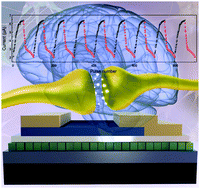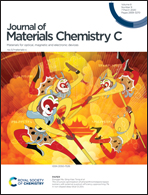Tailoring synaptic plasticity in a perovskite QD-based asymmetric memristor†
Abstract
Memristor devices have been of great interest over the past decade for the implementation of brain-inspired memory and computing owing to their inherent multistage memory, exquisite structure and higher integration. Herein, a CsPbBr3 QD-based protocol was constructed to exhibit analog memristive characteristics. The field-driven charge trapping/detrapping process was accelerated in the highlighted asymmetric electrode configuration to enable persistent dual direction current modulation, which serves as a basis for synaptic weight variation in the human brain. Significantly, the synaptic functions of long-term potentiation (LTP), long-term depression (LTD) and spike-timing-dependent plasticity (STDP) have been emulated on the device level. Furthermore, light signal-facilitated paired-pulse facilitation (PPF) behavior was validated with in situ atomic force microscopy (AFM) based on electrical techniques. These results may pave a new way to produce memristive devices with advanced implications for future neuromorphic computing.



 Please wait while we load your content...
Please wait while we load your content...